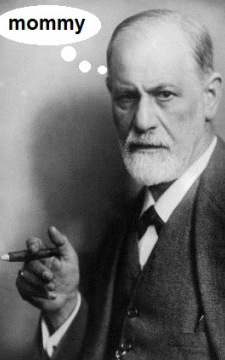
Does the image above catch your attention?
Of course it does, because male motivation is tied to sexual reproduction and men are motivated primarily by urges to have sex with females, right?
Wrong.
It’s more complex than that.
As far back as 1941 Scottish psychiatrist Ronald Fairbairn found that the desire for attachment in human beings, in terms of the overall psychobiological economy, is a more important necessity than the desire for sexual pleasure and reproduction.
You read it right: attachment is more important than sex.
This scientific finding, not controversial in the field of psychology, presents something of a heretical view to some in the Men’s Rights Movement who, by contrast, seem to have come in recent years to believe that males are chasing sexual reproduction only — which, oddly enough, seems similar to the stereotype of the “all men want is sex” misandrist paradigm we’ve all come to find so annoying.
Fairbairn’s proposition is now many decades old, but his findings heralded a Copernican revolution within the world of scientific research that would culminate in today’s attachment sciences; it moved the discussion beyond the reductionist sexual theories of Darwin and Freud and into new areas—more complex, more subtle, more nuanced, and ultimately more human.
The question attachment scientists explored is: why do couples continue to stay with each other years after producing offspring, and indeed sometimes for decades after all sexual activity has ceased in relationships? The answer is because human beings are pair bonders who get more out of attachment than they do out of fucking.
Since Fairbairn, studies have confirmed that humans possess an array of distinct motivational systems each in communication with the surrounding environment. Of those systems two are singled out as particularly powerful in motivating humans to form relationships – the sexual urge (eros), and -separately- the urge to attach. Of these, attachment is quite simply the most important to the continued survival of the individual. This cannot be overstated: attachment is the more important to individual survival.
As studies reveal, an absence of close and consistent human attachment causes children to literally wither and die, refusing to thrive even when being provided with clothing, food and an adequate number of toys. Children need reliable and consistent relationships in order to thrive. Likewise adults literally sicken both physically and mentally, and often commit suicide to escape feelings of isolation and loneliness, especially after a relationship separation.
A lack of sexual contact on the contrary is not as life threatening; you will never see someone die simply because they didn’t get to fuck with the opposite sex and reproduce. I would think that seals the case about what is really important to both men and women. Survival of the species depends on sex; survival of the individual depends on the vital bonds of attachment.
What does all this mean to men?
Well, it means that we need to evaluate separately our attachment needs and our sexual needs, and avoid the common mistake of conflating them; especially if that conflation sees us rejecting both when in fact it may be only one of these causing most of our relationship angst. It may turn out that attachment and sex both need to be rejected in our gynocentric zeitgeist because both are sources of entrapment, however that cannot be determined until we consider each factor separately and thoroughly.
In our psychobiological economy, various desires come into conflict with one another, each jostling for momentary supremacy where one imperative will usurp the claims of another. That game has reached a problematical impasse during the last 800 years because, during that (historically relatively short) time span, human culture has thrown the weight of its patronage into developing, intensifying and enforcing sexual gamesmanship to the degree that our sexual compulsions appear pumped up on steroids and taken to extremes never before seen in the human animal (myths about widespread Roman orgies notwithstanding).
If we lived back in Ancient Greece, Rome or anywhere else we would view sex as little more than a bodily function akin to eating, shitting and sleeping – a basic bodily function without the hype. After the Middle Ages however it developed into a commodity to pimp and trade, and the new cult of sexualized romance that arose resulted in a frustration of our basic need for attachment – a frustration aided and abetted by social institutions placing sexual manipulation at the centre of human interactions.
During these fairly recent centuries of increased hypergamy and sexual focus, our drive to pair-bond continues to shout its demands even while being neglected. Observe for example the not-infrequent feelings of disillusionment and loneliness of serial partner upgraders (hypergamy) or of promiscuous gamers, or consider a beautiful young woman living in her mansion with an aged but wealthy husband to whom she has little or no emotional attachment; even if she is getting sex on the side her loneliness can eat away at her sense of contentment. These examples reveal an urgency surrounding attachment when it is neglected for the sake of secondary sexual or power gains.
Like men, women desire secure attachment beyond whatever sexual advantages they can and do exploit. However the hypergamous compulsion tends to get in the way and frustrate their powerful need to pair-bond. From the Middle Ages all the way to today we read of men and women bitterly disillusioned by the interference of hypergamy in the desire to form stable pair-bonds. Read for instance the bitter, antifeminist complaints of 12th century Andreas Capellanus or those of 14th century Christine de Pizan, or the disillusionment and ultimate rejection of the benefits of hypergamy in later works like Madam Bovary. These authors knew full well that sexualized romantic love had upset the balance of attachment security for both men and women alike.
The question we must ask ourselves is this: can our human need for attachment be indulged without men and women succumbing to the destructive manipulations of the modern sex code? As we stand atop the mountain of bachelor freedoms, rightly rejecting gynocentric women and culture as bastions of exploitation, have we intellectually thrown out the attachment baby with the exploitation bathwater?
Sexual games need not get in the way of healthy attachment, so why should we live without relationships? Well no one ever said we had to, but in recent years I’ve sensed a trend both within and without the men’s activism community (which I’ve long been part of) that foregoing “relationships” is a necessary part of the deal.
This does not seem a prudent attitude to be cultivating, especially for young men who may now be reading advice about rejecting relations with women and making extreme decisions about their lives; refusing to marry, cohabit, or procreate does not require a cutting off from human society. Even if we don’t suicide from loneliness (as so many men do) we need to question if the absence of an intimate relationship in our lives can leave us limping, or somehow unfulfilled. Some will say no, and some of these naysayers may well be what are known as ‘avoidant attachers.’ Of those who would say yes, some might recommend we fill our intimacy void with friendships, which is I think a very good starting point. But this leads to a further question of whether there is an adequate formulation of friendship that can satisfy our needs in a modern context – a relationship that doesn’t rely on the usual corruption at the core of sexualized romantic love.
These questions lead to an exploration of adult human attachment, and modern studies on the subject are abundant from psychological, biological and behavioural points of view. For those interested in following this subject further the Wikipedia entry on Attachment in Adults would be a good place to start, and to branch out from there. Of particular interest is the existence of four basic attachment styles in human beings, indicating that there must also be four main ways of conducting relationships:
secure attachment (64% of the population)
anxious–preoccupied attachment (17% of the population)
fearful–avoidant attachment (12% of the population)
dismissive–avoidant attachment (7% of the population)
Only one of these styles (dismissive avoidant) involves a lack of desire for emotionally close relationships (relationships with minimal emotional intimacy may be tolerable to them), while the other three involve a desire to form emotionally intimate attachments. These are biologically-based traits appearing in each man before he considers rejecting intimacy with women, and they help to account for the behavioral and ideological variability we see among men – for the most part we are working creatively with what’s already in our make up rather than changing our core attachment style.
The four attachment styles and their implications for men deserve a follow up article. While some men’s rights advocates claim men do not need attachment at all, evidence is not in their favour. Thus, for most of us, constructing new ways to form secure relationships with our fellow humans in a rich and rewarding way is an important long-term question, even if we cannot pretend to have all the answers now; we start by knowing what we don’t want: relationships of enslavement and entrapment to the opposite sex (or anyone else for that matter) in an environment that makes healthy attachment difficult. But how do we forge a more positive model for human relationships and attachment for ourselves?
We started this essay with an important question: are sex and attachment two relatively different motivations? The answer is a resounding yes! Yes, despite all the pop culture bombardment of sex, sex, sex, the sexual shaming of men, and all the rest, the answer is yes: sex and attachment are not the same. People can live their lives avoiding sexual games but they will not end their lives happily unless they meet their attachment requirements. And while this journey will be different for each man, we must not flinch from seeing the problem for what it is: not “overcoming our urge to procreate,” but rather, how to be healthy human beings able to recognize and fulfill our natural need for human intimacy.
Sources
– Frederico Pereira, David E. Scharff, M. D. Fairbairn and Relational Theory (2002)
– Fairbairn, W.R.D., ‘Psychoanalytic Studies of the Personality’. (2013)
– Shaver, P.R., Handbook of attachment – Second Edition (2008)
– Shaver, P.R., Attachment in Adulthood: Structure, Dynamics and Change (2010)
Feature image by Thomas S.


